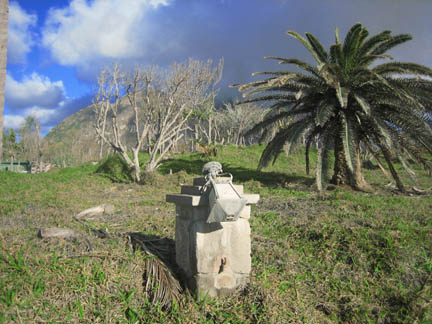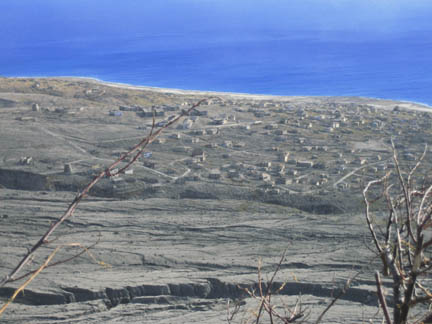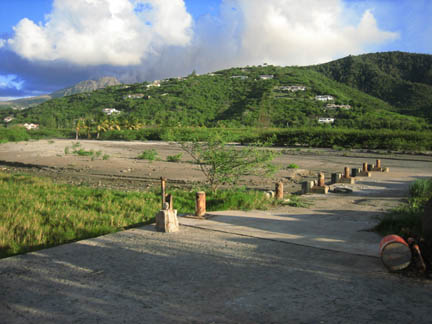| The Pompey of the Caribbean Monserrat, Feb 24-25, 2006 |
|
| | |
|
|
Montserrat: The home of the active volcano
|
The Pompey of the Caribbean
Monserrat, Feb 24-25, 2006Sailboat | Voyages | Log
Montserrat: The home of the active volcano
Dolphins guide us into Monserrat
What a thrill to see these beautiful fish
Oblivious to the destruction on the island

Half of Monserrat was destroyed by a volcano
In 1995-1997

The main city of Plymouth covered in lava and mud
Half of the city was literally buried alive

This concrete road was actually a jetty
Formerly in 15 feet of water,
Now reclaimed as land by the volcano
Karen with guide
Still beltching smoke and ash
Way off the beaten path
Two other boats with us in Little Bay
The highlight of our sail from Nevis to Monserrat was being guided by a school of dolphins. They swam beside, and just ahead, of Full Circle. They seemed to slow down to our seven knots and pop above the surface to let us know they were here. What draws them to a boat in motion is unclear; of course, there are many who think dolphins have a special link with humans, and we could certainly not disagree, since they clearly seemed to enjoy our company. And there is no doubt we enjoyed theirs. Like Bermuda, Monserrat is a British Overseas Territory, but unlike Bermuda, it is virtually unknown and unvisited. Known as the emerald island because of its once green hills and many Irish immigrants, it is now an island in decline. In 1995, the volcano Soufriere Hills erupted and buried the inhabited south of the island and the capital city of Plymouth. Churches, homes, and buildings were buried under sixty feet of lava and mud. With the massive destruction, people fled the island by the thousands, and the population plummeted from 11,000 to as low as two thousand. It is a tragic but fascinating situation. You can just imagine archeologists digging in the ruins a 1000 years from now studying what life was like in the ancient past of the 20th century.
The volcano has since quieted down, but it still belches smoke, steam, and ash. There is one small anchorage on the north of the island called Little Bay, and being overwhelmed with curiosity, we chose to spend a night there. It is unsafe in heavy seas, but we were fortunate to have mild seas, so in we went. We didnít arrive until nearly 4:00 pm but we were able to find George, a taxi driver, to act as our guide and take us to a spot on the south of the island were we could view the volcano and the remains of the capital city Plymouth. Most of the area is still restricted so we could not actually see the destruction close up. It was a fascinating experience to see how quickly nature can erase what man has created. Manís importance quickly diminishes when you see how quickly his work is swept away. The photos are a small attempt to capture the awesome sight we witnessed.
The next morning, when sailing past the remains of Plymouth , in the shadow of Soufriere, Full Circle was blanketed in thin film of ash, proof that the Soufriere was not yet finished.